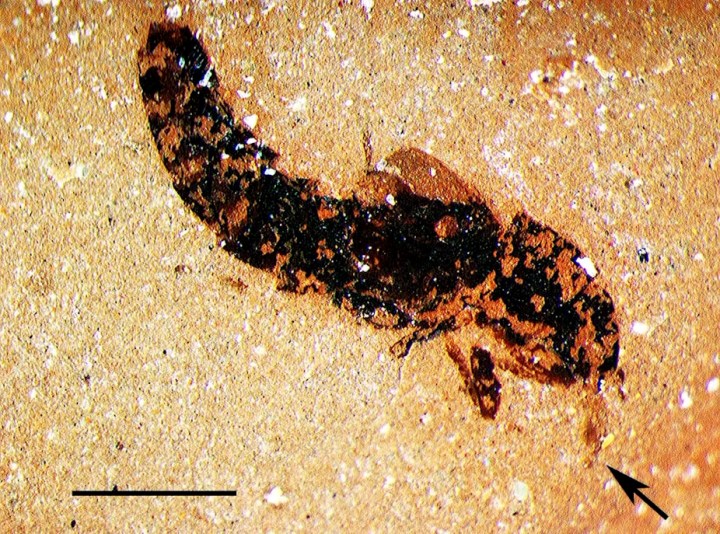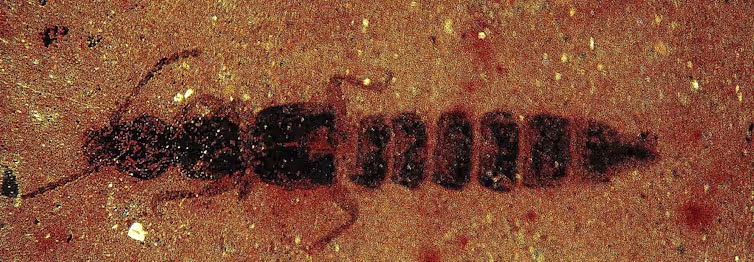THE CONVERSATION
Fossil beetles found in a Botswana diamond mine help us to reconstruct the distant past

When most people think of fossils they probably picture bones. But there’s much more to the global fossil record: plants, shells, minerals and insects. The study of fossil insects is called palaeoentomology. Palaeoentomologists like myself seek out and study fossil insects that were trapped in mud which later became rock sediments, and those found in amber (tree resin).
Very few deposits containing either fossil plants or fossil insects, or both, have been found so far on the African continent, or in the southern hemisphere more broadly, particularly those dating back to the Cretaceous period, some 145 million to 66 million years ago.
There are likely two reasons for the rarity of the deposits. The first is that there are very few researchers working on fossil insects compared to those researching dinosaurs and therapsids, for instance. The second could be a sampling bias (prioritising deposits that are already known), which is usually driven by the accessibility and interests.
One of the few Cretaceous age deposits that’s been discovered in Africa is at Botswana’s Orapa Diamond Mine. The mine, situated about 240km west of Francistown, has been dated using a sample of zircon isotopes on the sediments to be about 90 million years old. Based on geological processes we know to have occurred there, we’re able to say that the fossil insects preserved are the same age as the deposit.

A fossilised staphylinine rove beetle from Botswana’s Orapa diamond mine. (Photo: Terence McCarthy and Bruce Rubidge, Author provided)
Recently a team I lead discovered two new species of rove beetles preserved in the sediments of the Orapa Diamond Mine. Rove beetles are typically identified by their unique short elytra (protective wing cases) which expose the rest of the abdomen. Our finds are the first fossil rove beetles ever discovered on the continent and in the southern hemisphere. I’ve named the stenine rove beetle Afristenus orapensis and the staphylinine rove beetle Paleothius mckayi. The former is named after the deposit and the latter is named in honour of my mentor, the late Dr Ian James McKay, who died in 2022. He trained me to become the African continent’s first black palaeoentomologist.
The findings contribute to a more complete and accurate documentation of life on Earth, offering a clue into our planet’s long and intricate history. They also showcase how unchanged some life forms have been over the ages.
Rove beetles are highly adaptable and are found today in an array of environments around the world. They offer many ecosystem services. They are good environmental indicators, so they help us assess the health of the ecosystem. They are also used as biological control agents to reduce pest populations. They have a role in producing anti-septic and anti-cancer treatments. And they also help in breaking down and converting organic matter, contributing to both nutrient cycling and forensic science.
These discoveries inform us that the beetles and many other groups of insects were not just present, but were roaming and thriving alongside dinosaurs, and rove beetles haven’t changed much over millions of years. The fossils closely resemble today’s rove beetles, showing how successful they’ve been in adapting to various environments without significant changes to their bodies.
Identifying the fossils
I stumbled upon the rove beetles in the fossil material that had been collected from Orapa in the 1980s and is currently housed in the Herbarium of the Evolutionary Studies Institute at the University of the Witwatersrand in Johannesburg, South Africa.
We found the fossils in lacustrine sediments (deposits that accumulate in lake environments). Afristenus orapensis belongs to the stenine rove beetle subgroup while Paleothius mckayi belongs to the subgroup staphylinine.
Previously, both the stenine and staphylinine rove beetles had only been described in the northern hemisphere. The stenine rove beetle was previously described in Russia, France and Myanmar while the staphylinine rove beetle was previously described in Russia, China, Myanmar and England. So we scoured research articles about fossils of a similar age that have already been studied elsewhere for comparative purposes. This helped us to accurately interpret the Orapa finds.
The stenine rove beetle was preserved with something protruding from its front section. At first we thought it was a leg; and then we thought it was an antenna. After studying extant specimens of the group housed in South Africa’s Ditsong National Museum of Natural History, we realised it was a labium. The labium is an extremely long tongue-like feeding structure that extends from the mouth. Stenine rove beetles extend and use the labium to catch prey, in the same way as a chameleon does.
The staphylinine rove beetle was preserved with its distinctive features that helped us to identify it, including a symmetrical and elongated body form, exposed antennal insertions and a long first antennal segment. It had sharp scissor-like mouthparts, suggesting that it, like the stenine rove beetle, was a predator.
Both types of rove beetle would have been found hunting in leaf litter in and around a crater lake that flowed in what is today the Orapa Diamond Mine.
More to find
Our team has already discovered more fossil insects in the Orapa Diamond Mine collection. These include an aphid, thrips, planthoppers and leafhoppers. We are currently studying each specimen and preparing academic manuscripts that describe what we’ve found. These will also be peer-reviewed.
In the future, we are also hoping to construct a phylogeny (a representation of the evolutionary history and relationships between groups of organisms) that will show the relatedness of the morphological traits of the subgroups of the rove beetles and other groups of insects described from Orapa Diamond Mine. This will help us to precisely date them, and we can then use the divergence time estimates to trace back how far these subgroups have been related.
Studying fossil insects is painstaking work. My hope is that more money will be invested in training more palaeoentomologists in South Africa and on the continent more broadly. The study of fossil insects and plants is an important way to preserve our beloved continent’s heritage.![]() DM
DM
Sandiso Mnguni, GENUS Postdoctoral Research Fellow, University of the Witwatersrand
This article is republished from The Conversation under a Creative Commons license. Read the original article.





 Become an Insider
Become an Insider
What a wonderful story about past life on earth and humans’ amazing ability to constantly discover,question and research. Kudos to Sandiso and his team from bringing this story to light and for sharing on DM.
Amazing stuff still happening in SA, despite the doom & gloom.
Fascinating that some life forms have not changed for millions of years (sharks and coelacanths are others — both could have moved around in the sea to find suitable conditions). These bugs must also have found that the environment did not change enough that they had to “adapt of die” evolve.
Fascinating, thanks for sharing. Wishing you and your team great success in the future.
What an amazing story. Sandiso, you make me want to become a Palaeoentomologist, and I’m just an artist. This article has been most interesting. I’ll rather leave the palaeoentology for you, so I can read up on your next find om DM. Keep at it.